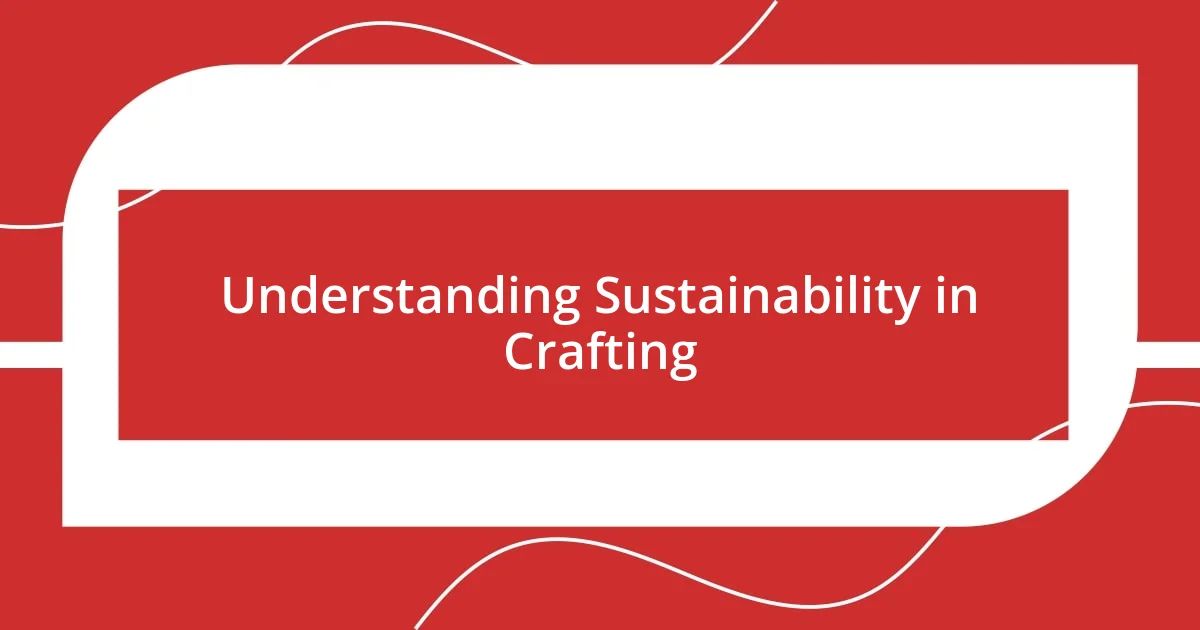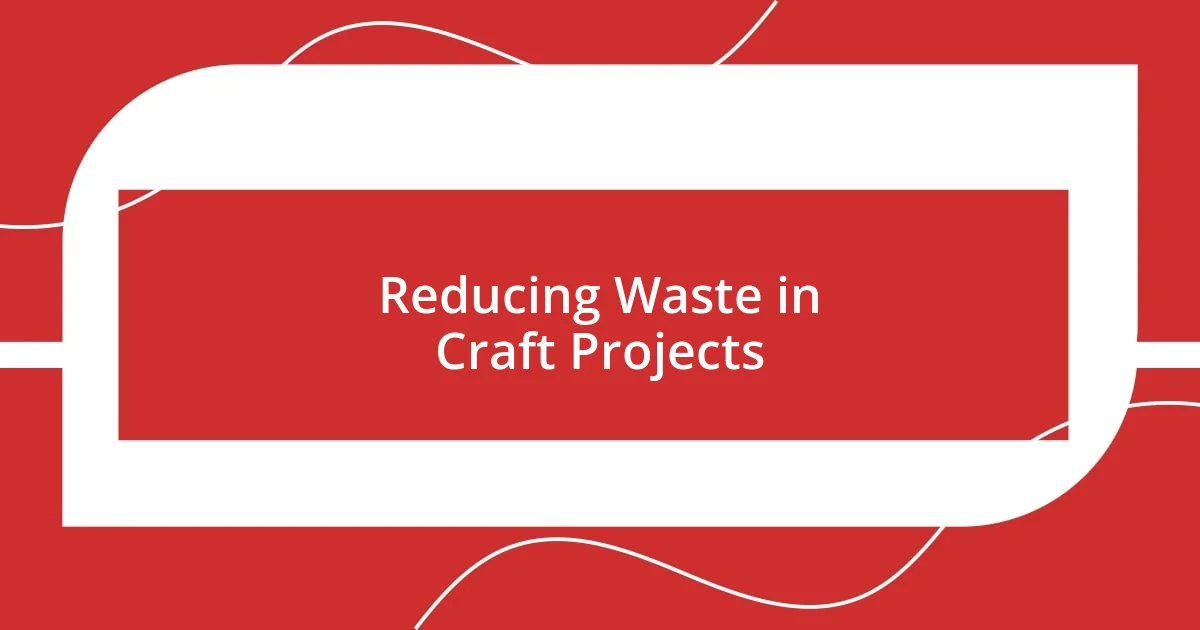Key takeaways:
- Sustainability in crafting involves not just eco-friendly materials but also a mindset that values and respects resources, fostering creativity and community connections.
- Utilizing eco-friendly materials like organic cotton, bamboo, and recycled items reduces waste and supports sustainable practices, transforming discarded goods into valuable projects.
- Community involvement and ethical sourcing enhance the crafting experience, encouraging collaboration and fostering a meaningful connection to the materials and the artisans behind them.

Understanding Sustainability in Crafting
Understanding sustainability in crafting extends beyond simply using eco-friendly materials. For me, it’s about cultivating a mindset that values the resources we have. Every time I create something, I think, “How can this project respect the environment?” This reflection adds depth to my creativity.
When I first started crafting, I remember the thrill of using bright, new materials without considering their origins. However, as I gained experience, I began to realize the impact of my choices. I’ve found immense satisfaction in repurposing items that would otherwise become waste. Have you ever looked at an old piece of furniture and imagined its potential? It’s like giving life back to something forgotten.
Sustainability is also about the crafting community we build. I cherish moments when I swap materials with friends or participate in workshops that emphasize upcycling. The joy of sharing knowledge and resources not only fosters creativity but strengthens connections. Isn’t that what crafting is all about?

Eco-Friendly Materials to Use
Using eco-friendly materials is a crucial step in sustainable crafting. I’ve had eye-opening experiences while exploring alternatives to traditional supplies. For instance, switching to organic cotton or linen instead of conventional fabric not only minimizes harmful chemicals but also supports sustainable farming practices. It’s amazing how a simple change like this can make our projects more environmentally conscious.
Another material that I’ve grown fond of is bamboo. I was initially drawn in by its beautiful texture, but I soon discovered that it’s one of the fastest-growing plants on Earth. This means it can be harvested sustainably without depleting resources. I often use bamboo in my projects, and I love the lightweight yet durable feel it brings. Have you ever tried crafting with bamboo? It adds a unique touch that is truly captivating.
Recycled materials are also fantastic options for eco-friendly crafting. I’ve often turned old magazines into collages and cards, and each piece tells a story. The thrill of breathing new life into discarded items is incomparable. It’s like a treasure hunt! By considering these materials, we not only reduce waste but also spark our creativity.
| Material | Benefits |
|---|---|
| Organic Cotton | Less chemical use, supports sustainable farming |
| Bamboo | Fast-growing, sustainable, durable |
| Recycled Paper | Reduces waste, adds unique character |

Techniques for Sustainable Crafting
Repurposing materials requires a bit of imagination, and I find that it’s often the most rewarding aspect of sustainable crafting. Just the other day, I came across a stack of old glass jars in my kitchen. Instead of tossing them, I transformed them into beautiful candle holders, adding a splash of color with eco-friendly paints. Not only did I create something lovely, but I also cleared some clutter at home. Repurposing doesn’t always have to be a big project; sometimes the simplest ideas can have the most profound impact.
Here are some techniques I’ve embraced for sustainable crafting:
- Upcycling: Turn discarded items into new creations; for example, old clothes can become trendy tote bags.
- Natural Dyes: Instead of synthetic dyes, I often use vegetable scraps or herbs to color fabrics, providing a beautiful, organic touch.
- Mending: I keep my loved garments alive through simple repairs, fostering a connection rather than replacing them.
- Community Swaps: I love organizing local events for exchanging crafting supplies with fellow crafters, which not only gives materials a second life but also builds a supportive community.
Sustainable crafting can be a deeply personal experience. When I engage in new techniques, I feel a sense of responsibility to the earth and the people around me. Last summer, I participated in a community project where we transformed a vacant lot into a garden with reclaimed wood and old tires. The joy of watching our crafting efforts bloom into something nurturing and vibrant was incredibly fulfilling. Each project becomes a story—one that honors the past while being mindful of our footprint on the planet.

Reducing Waste in Craft Projects
Finding ways to reduce waste in our craft projects brings a certain thrill that I love. Recently, I worked on a project where I used leftover fabric scraps to create beautiful patchwork coasters. Not only did I manage to keep those pieces out of the landfill, but the coasters also ended up being a wonderful conversation piece at my next gathering. Isn’t it satisfying to see something that was once seen as “waste” transformed into something functional and beautiful?
One of the biggest challenges is finding ways to minimize excess material right from the start. I’ve learned to carefully plan my projects and measure twice before cutting—this simple habit prevents waste and makes my crafting process more thoughtful. Storytime: when I made a quilt last year, I took the time to sketch out my design and cut pieces efficiently. I was amazed at how few scraps I had left! This mindset can truly change how we view our crafting – every little choice counts.
Sometimes, thinking outside the box leads to the best solutions. For instance, I had an overflow of cardboard boxes after a recent move. Instead of tossing them, I crafted unique greeting cards and gift boxes. It’s incredible how a little creativity can transform what seems like trash into treasure. Have you ever used unexpected materials to reduce waste? It’s a fun way to innovate and keep our crafting adventures sustainable!

Supporting Ethical Crafting Practices
Supporting ethical crafting practices starts with being conscious about where our materials come from. I remember when I shifted to sourcing my supplies from local artisans instead of big box stores. It felt good to foster a connection with the people behind the products. This not only supports small businesses, but it also builds a sense of community that’s lost in mass production. Have you ever thought about how your choices can directly impact someone’s livelihood? It’s a rewarding realization that I cherish.
Additionally, I make it a point to prioritize materials that are sustainably sourced. A while back, I stumbled upon a supplier offering ethically-produced wool, and it completely changed my perspective. Knowing that the sheep were treated well and the land was cared for made my crafting feel more meaningful. This emotional connection to the sourcing process deepens my appreciation for my projects. Have you explored ethical choices in your crafting journey yet? It might just transform how you see your work.
Incorporating fair-trade items is another practice I actively support. Not long ago, I purchased hand-woven baskets from a fair-trade cooperative. Each piece I craft from those baskets feels special—not just because of their beauty, but because I know my purchase helped empower artisans in their communities. It sparks a thought: what if we all dedicated part of our crafting budget to fair-trade items? The collective impact could be significant, fostering an ethical crafting culture while creating beautiful art.

Community Involvement in Sustainability
Community involvement is a powerful catalyst for sustainability in crafting. A few months back, I joined a local crafting group that focuses on upcycling materials for community projects. Seeing everyone come together to transform discarded items into beautiful creations felt incredible. It made me wonder: how much more could we achieve if every neighborhood organized similar initiatives?
I recall a community event where we pooled our resources to create handmade gifts for a nearby shelter. It was heartwarming to witness everyone’s creativity shining through as we crafted with purpose. This experience not only reinforced my commitment to sustainable practices but also highlighted the importance of collaboration. Isn’t it wonderful how working together can elevate the impact of our individual efforts, turning crafting into a community affair?
Moreover, volunteering for local environmental efforts has opened my eyes to the broader context of sustainability. I participated in a clean-up drive recently and was inspired by the team spirit of everyone involved. It made me think about how this sense of unity can flow into our crafting practices. Imagine what we could accomplish if crafters regularly contributed their skills to local causes! It’s a beautiful way to channel our passion into real change, enriching our community while creating art that truly resonates.















